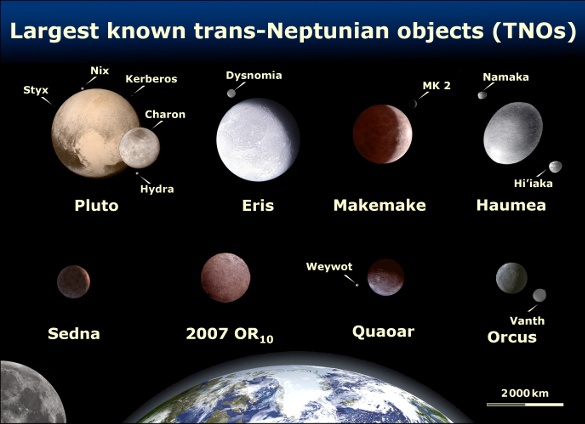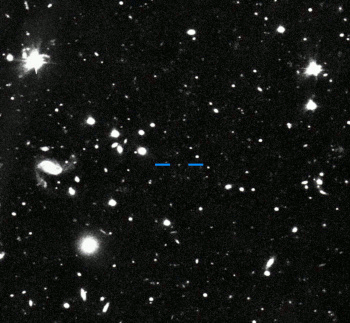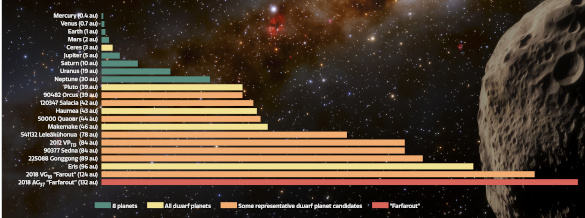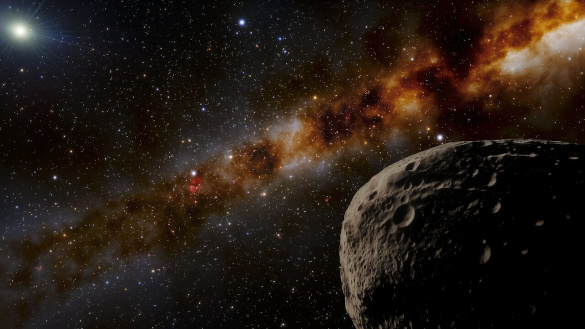Farfarout
April 19, 2021
The
expression,
far out, was current during my
college days as meaning something excellent. It was apparently used in the same sense in
jazz circles at least a
decade earlier. The expression was used in the the
1970s in the
exclamation, "It's so far out, it's in." That's a good explanation for the popularity of
vintage clothing. There's a type of
pudding called
flummery, and a flummery
product was
advertised in those days in a
television commercial that I still recall. It showed a
colonial period American housewife tasting a batch she was
cooking and saying the
comedic anachronism, "far out." The name,
Farfarout, has been given to a recently discovered most distant object of our
Solar System that's now formally known as
2018 AG37.[1-3]
In an
earlier article (Planet Nine, June 27, 2016), I described
observations that seemed to indicate the existence of a
planet-sized object in the far reaches of the Solar System. This would be a true ninth planet, taking the place of
demoted Pluto, and it's been given the name,
Planet 9.[4]
orbital irregularities in distant Solar System objects indicate that such a planet might exist in a highly
elliptical orbit that places it far from
astronomers' searching eyes most of the time.[5] Planet 9 has not been directly observed, and there is the problem of how such a large planet might have formed.[6] Its highly elliptical orbit places it at distances from the Sun of about 40-140 billion
miles (400 - 1500
astronomical units (au)).[6]

When I was in school, I just needed to learn the names of a few Solar System objects. Even ignoring the named moons, the Solar System has many new members near the orbit of Pluto. These Trans-Neptunian objects include Eris, Makemake, Haumea, Sedna, 2007 OR10, Quaoar, and Orcus. (Wikimedia Commons image by Lexicon.)
Farfarout wasn't named "Farout," since that name was already used as a common name for the previous most distant object,
Farout (2018 VG
18), discovered in 2018 by the same team of astronomers that discovered Farfarout. Farout is about 100 au from the
Sun. It might be in the size range to qualify as a
dwarf planet candidate, since estimates based on its
absolute magnitude give a diameter of about 310 miles (500
kilometers).
In the past, before
electronic imaging, such objects were discovered by using a
blink comparator to examine
photographic plates exposed on successive nights. Since the
human eye is very sensitive to
motion, flipping between two images of the same region of the sky easily reveals moving objects against the background of
fixed stars. Today,
software accomplishes this same task of finding such moving objects.

Blink comparison of Farfarout, 2018 AG37, the most distant object discovered to date in our Solar System. Farfarout is 132 astronomical units (au) from the Sun, and its estimated to be about 250 miles (400 kilometers) in diameter.
Although the object is highlighted in these images, its motion would be apparent through cycling of the original images.
(Animation created using the GNU Image Manipulation Program (GIMP) from source images by NOIRLab/NSF/AURA/J. da Silva, licensed under a Creative Commons Attribution 4.0 International License.
Farfarout is much farther away from the Sun than Farout. It's 132.2 ± 1.5 astronomical units (19.78 ± 0.22 billion kilometers) from the Sun, and its estimated to be about 250 miles (400 kilometers) in diameter, which is at the lower limit for the size of a dwarf planet as defined by the
International Astronomical Union (IAU). It was discovered by
Scott S. Sheppard,
David J. Tholen, and
Chad Trujillo at the
Mauna Kea Observatory on January 15, 2018, during a search for the elusive Planet 9.[1-2] Farfarout is very faint, having an
apparent magnitude of 25, so it can be observed only by the largest
telescopes. It's slow movement arising from its 1,000-year
orbital period requires several
years of observation to determine a precise orbit.[3]

This graph shows the distances from the Sun in astronomical units (au) of the planets, dwarf planets, and the candidate dwarf planets, Farout, and Farfarout. Farfarout is 132 au from the Sun. (Portion of a NOIRLab/NSF/AURA/J. da Silva image, licensed under a Creative Commons Attribution 4.0 International License. Click for larger image.)
Since Farfarout's existence has been confirmed my multiple observations, it received its 2018 AG
37 designation from the International Astronomical Union.[1-2] This provisional number is constructed from the discovery
date, an "A" indicating first half of
January, and the subsequent
letter and numbers marking it as the 932nd object discovered in that half-
month. Farfarout will receive an official name after a better orbital determination, which will take several years.[2]
Farfarout's orbit is quite elongated, with an
aphelion (farthest distance from the Sun) of 175 au and a
perihelion (closest distance from the Sun) about 27 au.[1-2] The perihelion is inside the orbit of
Neptune, and the strong
gravitational interaction of Farfarout with Neptune is likely the reason for its elongated orbit.[1-2] This strong interaction with Neptune means that the orbit of Farfarout can't be used to determine the presence of other massive objects at the periphery of the Solar System.[2]
Farfarout's discoverers are confident that they will find objects even more distant; so, just as Farout was replaced by Farfarout as the Solar System's most distant object, there should be some Far
nout objects out there.[1] Says
Scott Sheppard of the
Carnegie Institution for Science and co-discoverer of both Farout and Farfarout,
"The discovery of Farfarout shows our increasing ability to map the outer solar system and observe farther and farther towards the fringes of our solar system... Only with the advancements in the last few years of large digital cameras on very large telescopes has it been possible to efficiently discover very distant objects like Farfarout. Even though some of these distant objects are quite large, being dwarf planet in size, they are very faint because of their extreme distances from the Sun. Farfarout is just the tip of the iceberg of solar system objects in the very distant solar system."[2]

An Artist's impression of how Farfarout might appear. The bright object at the upper left is the Sun, and the Milky Way appears as the diagonal streak. (NOIRLab/NSF/AURA/J. da Silva image, licensed under a Creative Commons Attribution 4.0 International License. Click for larger image.)
References:
- Astronomers Confirm Solar System's Most Distant Known Object Is Indeed Farfarout, noirlab2108 Science Release, February 10, 2021.
- 'Farfarout!' Solar system's most distant planetoid confirmed, University of Hawaii Press Release, February 10, 2021.
- Minor Planet Electronic Circular MPEC 2021-C187:2018 AG37, February 10, 2019
- Scott Sheppard, "Beyond Pluto: the Hunt for a Massive Planet X," Carnegie Institution for Science, February 21, 2019.
- Chadwick A. Trujillo and Scott S. Sheppard, "A Sedna-like body with a perihelion of 80 astronomical units," Nature, vol. 507, no. 7493 (March 27, 2014), pp.471-474, DOI:https://doi.org/10.1038/nature13156.
- Christine Pulliam, "Planet Nine: A World That Shouldn't Exist," Harvard-Smithsonian Center for Astrophysics Press Release No. 2016-11, May 3, 2016.
- K. J. Napier, D. W. Gerdes, Hsing Wen Lin, S. J. Hamilton, G. M. Bernstein, P. H. Bernardinelli, T. M. C. Abbott, M. Aguena, J. Annis, S. Avila, D. Bacon, E. Bertin, D. Brooks, D. L. Burke, A. Carnero Rosell, M. Carrasco Kind, J. Carretero, M. Costanzi, L. N. da Costa, J. De Vicente, H. T. Diehl, P. Doel, S. Everett, I. Ferrero, P. Fosalba, J. García Bellido, D. Gruen, R. A. Gruendl, G. Gutierrez, D. L. Hollowood, K. Honscheid, B. Hoyle, D. J. James, S. Kent, K. Kuehn, N. Kuropatkin, M. A. G. Maia, F. Menanteau, R. Miquel, R. Morgan, A. Palmese, F. Paz-Chinchón, A. A. Plazas, E. Sanchez, V. Scarpine, S. Serrano, I. Sevilla-Noarbe, M. Smith, E. Suchyta, M. E. C. Swanson, C. To, A. R. Walker, and R. D. Wilkinson, "No Evidence for Orbital Clustering in the Extreme Trans-Neptunian Objects," arXiv, February 11, 2021.
- Rafi Letzter, "Planet 9 probably doesn't exist, new paper argues," LiveScience, February 18, 2021.
Linked Keywords: Expression; sentence (linguistics); college; jazz; decade; 1970s; interjection; exclamation; vintage clothing; pudding; flummery; product (business); advertising; advertised; television advertisement; television commercial; Thirteen Colonies; colonial period; American; housewife; taste; tasting; cooking; comedy; comedic; anachronism; Solar System; 2018 AG37; observational astronomy; observation; planet; IAU definition of planet; Pluto; Planet Nine; Planet 9; orbital elements; elliptical; astronomer; mile; astronomical units (au); elementary school - United States; natural satellite; moon; orbit; Trans-Neptunian object; Eris (dwarf planet); Makemake (dwarf planet); Haumea (dwarf planet); 90377 Sedna; (225088) 2007 OR10; 50000 Quaoar; 90482 Orcus; Wikimedia Commons; User: Lexicon; 2018 VG18; Farout; Sun; dwarf planet; absolute magnitude; kilometer; digital photography; electronic imaging; blink comparator; photographic plate (astronomy); exposure (photography); exposed; human eye; motion (physics); fixed stars; computer software; animation; GNU Image Manipulation Program (GIMP); NOIRLab/NSF/AURA/J. da Silva; Creative Commons Attribution 4.0 International License; International Astronomical Union (IAU); Scott S. Sheppard; David J. Tholen; Chad Trujillo; Mauna Kea Observatory; apparent magnitude; optical telescope; orbital period; years; chart; graph; calendar date; January; alphabet letter; month; aphelion; perihelion; Neptune; gravitation; gravitational; interaction; Carnegie Institution for Science; digital camera; tip of the iceberg; artist's impression; Milky Way; diagonal.